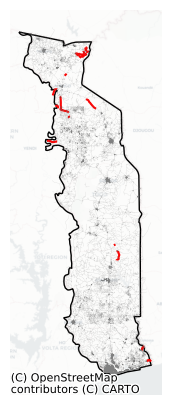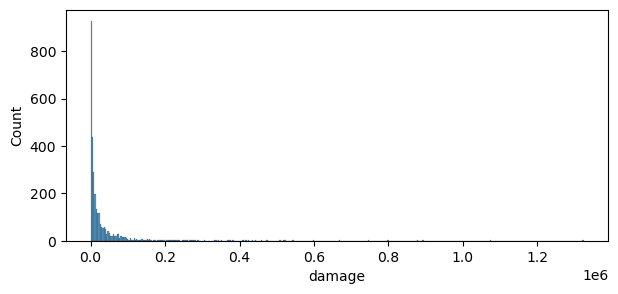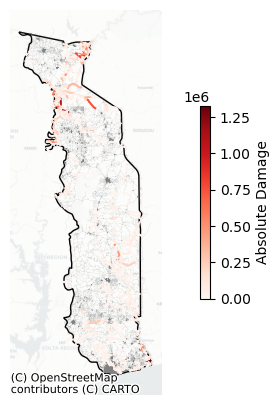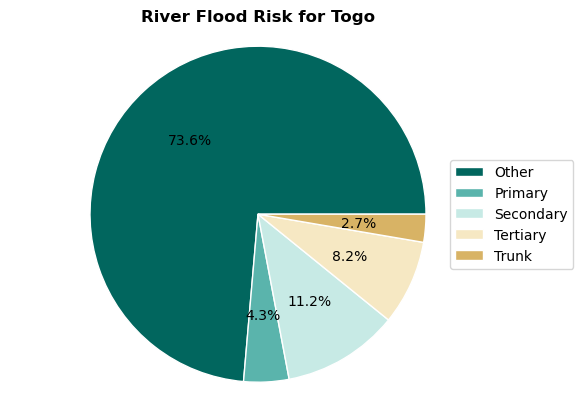Transportation Infrastructure#
In this notebook, we will perform a damage and risk assessment for transportation infrastructure, specifically focusing on roads. The assessment is based on combining hazard data (e.g., flood depths) with vulnerability curves to estimate the potential damage to infrastructure.
We will follow the steps outlined below to conduct the assessment:
Loading the necessary packages:
We will import the Python libraries required for data handling, analysis, and visualization.Loading the data:
The infrastructure data (e.g., roads) and hazard data (e.g., flood depths) will be loaded into the notebook.Preparing the data:
The infrastructure and hazard data will be processed and data gaps can be filled, if required.Performing the damage assessment:
We will apply vulnerability curves to estimate the potential damage based on the intensity of the hazard.Visualizing the results:
Finally, we will visualize the estimated damage using graphs and maps to illustrate the impact on transportation infrastructure.
1. Loading the Necessary Packages#
To perform the assessment, we are going to make use of several python packages.
In case you run this in Google Colab, you will have to install the packages below (remove the hashtag in front of them).
#!pip install damagescanner==0.9b14
#!pip install contextily
#!pip install exactextract
#!pip install lonboard
In this step, we will import all the required Python libraries for data manipulation, spatial analysis, and visualization.
import warnings
import xarray as xr
import numpy as np
import pandas as pd
import geopandas as gpd
import seaborn as sns
import shapely
import matplotlib.pyplot as plt
import contextily as cx
import damagescanner.download as download
from damagescanner.core import DamageScanner
from damagescanner.osm import read_osm_data
from damagescanner.base_values import DICT_CIS_VULNERABILITY_FLOOD
from lonboard import viz
warnings.simplefilter(action='ignore', category=FutureWarning)
warnings.simplefilter(action='ignore', category=RuntimeWarning) # exactextract gives a warning that is invalid
Specify the country of interest#
Before we continue, we should specify the country for which we want to assess the damage. We use the ISO3 code for the country to download the OpenStreetMap data.
country_full_name = 'Togo'
country_iso3 = 'TGO'
2. Loading the Data#
In this step, we will load four key datasets:
Infrastructure data:
This dataset contains information on the location and type of transportation infrastructure (e.g., roads). Each asset may have attributes such as type, length, and replacement cost.Hazard data:
This dataset includes information on the hazard affecting the infrastructure (e.g., flood depth at various locations).Vulnerability curves:
Vulnerability curves define how the infrastructure’s damage increases with the intensity of the hazard. For example, flood depth-damage curves specify how much damage occurs for different flood depths.Maximum damage values:
This dataset contains the maximum possible damage (in monetary terms) that can be incurred by individual infrastructure assets. This is crucial for calculating total damage based on the vulnerability curves.
Infrastructure Data#
We will perform this example analysis for Togo. To start the analysis, we first download the OpenStreetMap data from GeoFabrik. In case of locally available data, one can load the shapefiles through gpd.read_file(), as we show in the second cell within this section.
infrastructure_path = download.get_country_geofabrik(country_iso3)
Now we load the data and read only the road data.
%%time
features = gpd.read_file(infrastructure_path, layer="lines")
features = features[features["highway"].values != None]
CPU times: total: 10.4 s
Wall time: 12.7 s
sub_types = ['motorway', 'motorway_link', 'trunk', 'trunk_link',
'primary', 'primary_link', 'secondary', 'secondary_link', 'tertiary',
'tertiary_link', 'residential', 'road', 'unclassified','track']
features = features[features['highway'].isin(sub_types)].reset_index(drop=True)
These are many subtypes to consider, so we combine some
features = features.replace({'highway' : { 'motorway_link' : 'motorway',
'trunk_link' : 'trunk',
'primary_link' : 'primary' ,
'secondary_link' : 'secondary',
'tertiary_link' : 'tertiary',
'primary_link' : 'primary',
'residential' : 'other' ,
'road' : 'other',
'unclassified' : 'other',
'track' : 'other',
}})
Now define a new set of sub_types, to be used in the remainder of this analysis
sub_types = ['motorway', 'trunk','primary', 'secondary', 'tertiary', 'other']
Hazard Data#
For this example, we make use of the flood data provided by CDRI.
We use a 1/100 flood map to showcase the approach.
hazard_map = xr.open_dataset("https://hazards-data.unepgrid.ch/global_pc_h100glob.tif", engine="rasterio")
hazard_map
<xarray.Dataset> Size: 747GB
Dimensions: (band: 1, x: 432000, y: 216000)
Coordinates:
* band (band) int32 4B 1
* x (x) float64 3MB -180.0 -180.0 -180.0 ... 180.0 180.0 180.0
* y (y) float64 2MB 90.0 90.0 90.0 90.0 ... -90.0 -90.0 -90.0 -90.0
spatial_ref int32 4B ...
Data variables:
band_data (band, y, x) float64 746GB ...Maximum damages#
One of the most difficult parts of the assessment is to define the maximum reconstruction cost of particular assets. Here we provide a baseline set of values, but these should be updated through national consultations.
maxdam_dict = {'trunk':2000,
'motorway' : 2000,
'primary':2000,
'secondary':1300,
'tertiary':700,
'other':300 }
To be used in our damage assessment, we convert this to a Pandas DataFrame
maxdam = pd.DataFrame.from_dict(maxdam_dict,orient='index').reset_index()
maxdam.columns = ['object_type','damage']
And check if any of the objects are missing from the dataframe.
missing = set(sub_types) - set(maxdam.object_type)
if len(missing) > 0:
print(f"Missing object types in maxdam: \033[1m{', '.join(missing)}\033[0m. Please add them before you continue.")
Vulnerability data#
Similarly to the maximum damages, specifying the vulnerability curves is complex. We generally have limited information about the quality of the assets, its level of deteriation and other asset-level characteristics. The study by Nirandjan et al. (2024) provides us with a baseline set of fragility and vulnerability curves that one can use. In the following cell, we load that data.
vulnerability_path = "https://zenodo.org/records/10203846/files/Table_D2_Multi-Hazard_Fragility_and_Vulnerability_Curves_V1.0.0.xlsx?download=1"
vul_df = pd.read_excel(vulnerability_path,sheet_name='F_Vuln_Depth')
And let’s have a look at all the available options
with pd.option_context('display.max_rows', None, 'display.max_colwidth', None):
display(vul_df.iloc[:2,:].T)
| 0 | 1 | |
|---|---|---|
| ID number | Infrastructure description | Additional characteristics |
| F1.1 | plant | Small power plants, capacity <100 MW |
| F1.2 | plant | Medium power plants, capacity 100-500 MW |
| F1.3 | plant | Large power plants, >500 MW |
| F1.4 | plant | thermal plant |
| F1.5 | plant | wind turbine |
| F1.6 | plant | wind turbine |
| F1.7 | plant | wind turbine |
| F2.1 | substation | Low Voltage Substation |
| F2.2 | substation | Medium Voltage Substation |
| F2.3 | substation | High Voltage Substation |
| F5.1 | cable | Distribution circuits buried crossings |
| F6.1 | Power (minor) line | Distribution circuits (non-crossings) |
| F6.2 | cable | Distribution circuits elevated crossings |
| F6.3 | Energy system | Generalized curve for energy assets in diked areas |
| F7.1 | Roads | NaN |
| F7.2 | Roads | NaN |
| F7.2a (lower boundary) | Roads | NaN |
| F7.2b (upper boundary) | Roads | NaN |
| F7.3 | Roads | NaN |
| F7.4 | Roads | Motorways and trunk roads - sophisticated accessories - low flow |
| F7.5 | Roads | Motorways and trunk roads - sophisticated accessories - high flow |
| F7.6 | Roads | Motorways and trunk roads - without sophisticated accessories - low flow |
| F7.7 | Roads | Motorways and trunk roads - without sophisticated accessories - high flow |
| F7.8 | Roads | Other roads - low flow |
| F7.9 | Roads | Other roads - high flow |
| F7.10 | Roads | NaN |
| F7.11 | Roads | NaN |
| F7.12 | Roads | NaN |
| F7.13 | Roads | NaN |
| F8.1 | Railways | Double-tracked railway |
| F8.2 | Railways | Double-tracked railway |
| F8.3 | Railways | NaN |
| F8.4 | Railways | NaN |
| F8.5 | Railways | NaN |
| F8.6 | Railways | NaN |
| F8.6a (lower boundary) | Railways | NaN |
| F8.6b (upper boundary) | Railways | NaN |
| F8.7 | Railways | NaN |
| F8.8 | Railways | Railway station |
| F9.1 | Airports | NaN |
| F9.2 | Airports | NaN |
| F9.3 | Airports | NaN |
| F10.1 | Telecommunication | Communication tower |
| F12.1 | Telecommunication | Communication system |
| F13.1 | water storage tanks | Water storage tanks at grade concrete |
| F13.2 | water storage tanks | Water storage tanks at grade steel |
| F13.3 | water storage tanks | Water storage tanks at grade wood |
| F13.4 | water storage tanks | Water storage tanks elevated |
| F13.5 | water storage tanks | Water storage tanks below grade |
| F14.1 | Water treatment plants | Small water treatment plants open/gravity - average flood design |
| F14.2 | Water treatment plants | Medium water treatment plants open/gravity - average flood design |
| F14.3 | Water treatment plants | Large water treatment plants open/gravity - average flood design |
| F14.4 | Water treatment plants | small/medium/large water treatment plants open/gravity - above average flood design |
| F14.5 | Water treatment plants | small/medium/large water treatment plants open/gravity - below average flood design |
| F14.6 | Water treatment plants | Small water treatment plants closed/pressure |
| F14.7 | Water treatment plants | Medium water treatment plants closed/pressure |
| F14.8 | Water treatment plants | Large water treatment plants closed/pressure |
| F14.9 | Water treatment plants | small/medium/large water treatment plants closed/pressure - above average flood design |
| F14.10 | Water treatment plants | small/medium/large water treatment plants closed/pressure - below average flood design |
| F15.1 | Water well | Wells |
| F16.1 | Transmission and distribution pipelines | Exposed transmission pipeline crossing |
| F16.2 | Transmission and distribution pipelines | Buried transmission pipeline crossing |
| F16.3 | Transmission and distribution pipelines | Pipelines (non-crossing) |
| F17.1 | Others | Pumping plants (small) below grade |
| F17.2 | Others | Pumping plants (medium/large) below grade |
| F17.3 | Others | Pumping plants (small) above grade |
| F17.4 | Others | Pumping plants (medium/large) above grade |
| F17.5 | Others | Pumping plants |
| F17.6 | Others | Control vaults and stations |
| F18.1 | Wastewater treatment plant | Small wastewater treatment plants |
| F18.2 | Wastewater treatment plant | Medium wastewater treatment plants |
| F18.3 | Wastewater treatment plant | Large wastewater treatment plants |
| F18.4 | Wastewater treatment plant | Small, medium, large Wastewater treatment plants - above average flood design |
| F18.5 | Wastewater treatment plant | Small, medium, large Wastewater treatment plants- below average flood design |
| F18.6 | Wastewater treatment plant | NaN |
| F19.1 | Transmission and distribution pipelines | Sewers & Interceptors: Exposed collector river crossings |
| F19.2 | Transmission and distribution pipelines | Sewers & Interceptors: Buried collector river crossings |
| F19.3 | Transmission and distribution pipelines | Sewers & Interceptors: Pipes (non-crossings) |
| F20.1 | Others | Control vaults and control stations |
| F20.2 | Others | Lift stations: lift station (small), wet well/dry well |
| F20.3 | Others | Lift stations: lift station (medium large), wet well/dry well |
| F20.4 | Others | Lift stations: lift station (small), submersible |
| F20.5 | Others | Lift stations: lift station (medium large), submersible |
| F21.1 | Education & Health | Generalized curve for commercial buildings, which also includes schools and hospitals |
| F21.2 | Education & Health | Generalized curve for commercial buildings, which also includes schools and hospitals |
| F21.3 | Education & Health | Generalized curve for commercial buildings, which also includes schools and hospitals |
| F21.3a (lower boundary) | Education & Health | Generalized curve for commercial buildings, which also includes schools and hospitals |
| F21.3b (upper boundary) | Education & Health | Generalized curve for commercial buildings, which also includes schools and hospitals |
| F21.4 | Education & Health | Generalized curve for commercial buildings, which also includes schools and hospitals |
| F21.4a (lower boundary) | Education & Health | Generalized curve for commercial buildings, which also includes schools and hospitals |
| F21.4b (upper boundary) | Education & Health | Generalized curve for commercial buildings, which also includes schools and hospitals |
| F21.5 | Education & Health | Generalized curve for commercial buildings, which also includes schools and hospitals |
| F21.5a (lower boundary) | Education & Health | Generalized curve for commercial buildings, which also includes schools and hospitals |
| F21.5b (upper boundary) | Education & Health | Generalized curve for commercial buildings, which also includes schools and hospitals |
| F21.6 | Education & Health | Generalized curve for commercial buildings, which also includes schools and hospitals |
| F21.7 | School buildings | Generalized curve for companies (incl. government) |
| F21.8 | Health & education | Generalized curve for offices in diked areas |
| F21.9 | Education & Health | Generalized function for industry |
| F21.10 | School buildings | Generalized curve for buildings |
| F21.11 | School buildings | NaN |
| F21.12 | Health buildings | NaN |
| F21.13 | Education buildings | NaN |
And select a curve to use for each different subtype we are analysing.
sub_types
['motorway', 'trunk', 'primary', 'secondary', 'tertiary', 'other']
selected_curves = dict(zip(sub_types,['F7.5','F7.5','F7.5','F7.7','F7.7','F7.9']))
The next step is to extract the curves from the database, and prepare them for proper usage into our analysis.
We start by selecting the curve IDs from the larger pandas DataFrame vul_df:
damage_curves = vul_df[['ID number']+list(selected_curves.values())]
damage_curves = damage_curves.iloc[4:125,:]
Then for convenience, we rename the index name to the hazard intensity we are considering.
damage_curves.set_index('ID number',inplace=True)
damage_curves.index = damage_curves.index.rename('Depth')
And make sure that our damage values are in floating numbers.
damage_curves = damage_curves.astype(np.float32)
And ensure that the columns of the curves link back to the different asset types we are considering:
damage_curves.columns = sub_types
There could be some NaN values at the tail of some of the curves. To make sure the code works, we fill up the NaN values with the last value of each of the curves.
damage_curves = damage_curves.fillna(method='ffill')
Finally, make sure we set the index of the damage curves (the inundation depth) in the same metric as the hazard data (e.g. meters or centimeters).
damage_curves.index = damage_curves.index*100
Ancilliary data for processing#
world = gpd.read_file("https://github.com/nvkelso/natural-earth-vector/raw/master/10m_cultural/ne_10m_admin_0_countries.shp")
world_plot = world.to_crs(3857)
admin1 = gpd.read_file("https://github.com/nvkelso/natural-earth-vector/raw/master/10m_cultural/ne_10m_admin_1_states_provinces.shp")
3. Preparing the Data#
Change the column name of the object data, to ensure we can use the same functions across different infrastructure assets
features = features.rename(columns = {'highway' : 'object_type'})
Clip the hazard data to the country of interest.
country_bounds = world.loc[world.ADM0_ISO == country_iso3].bounds
country_geom = world.loc[world.ADM0_ISO == country_iso3].geometry
hazard_country = hazard_map.rio.clip_box(minx=country_bounds.minx.values[0],
miny=country_bounds.miny.values[0],
maxx=country_bounds.maxx.values[0],
maxy=country_bounds.maxy.values[0]
)
hazard_country = hazard_country.rio.set_crs(4326)
4. Performing an Exposure Assessment#
We will use the DamageScanner approach. This is a fully optimised damage calculation method, that can capture a wide range of inputs to perform a damage assessment. It also allows to only assess the potential exposure.
exposure_results = DamageScanner(hazard_country, features, damage_curves, maxdam).exposure()
Overlay raster with vector: 100%|██████████████████████████████████████████████████████| 44/44 [06:59<00:00, 9.55s/it]
convert coverage to meters: 100%|████████████████████████████████████████████████| 3519/3519 [00:02<00:00, 1266.98it/s]
5. Performing a Vulnerability Assessment#
In some cases, the cost information is unavailable, or one wants to explore only the exposure and vulnerability. To do so, we simply run the DamageScanner, by setting the maximum costs to 1.
vulnerability_maxdam = maxdam.copy()
vulnerability_maxdam.loc[:,'damage'] = maxdam['damage']/maxdam['damage']
%%time
vulnerability_results = DamageScanner(hazard_country, features, damage_curves, vulnerability_maxdam).calculate()
Overlay raster with vector: 100%|██████████████████████████████████████████████████████| 44/44 [04:44<00:00, 6.46s/it]
convert coverage to meters: 100%|████████████████████████████████████████████████| 3519/3519 [00:02<00:00, 1255.97it/s]
Calculating damage: 100%|███████████████████████████████████████████████████████| 3519/3519 [00:00<00:00, 12236.23it/s]
CPU times: total: 4min 12s
Wall time: 4min 53s
6. Performing the Damage Assessment#
In case we do have cost values, we can fully assess the damages.
%%time
damage_results = DamageScanner(hazard_country, features, damage_curves, maxdam).calculate()
Overlay raster with vector: 100%|██████████████████████████████████████████████████████| 44/44 [05:13<00:00, 7.13s/it]
convert coverage to meters: 100%|████████████████████████████████████████████████| 3519/3519 [00:03<00:00, 1110.97it/s]
Calculating damage: 100%|████████████████████████████████████████████████████████| 3519/3519 [00:00<00:00, 9280.90it/s]
CPU times: total: 4min 33s
Wall time: 5min 25s
7. Save the Results#
For further analysis, we can save the results in their full detail, or save summary estimates per subnational unit. We show how to do this using the damage results.
hazard = 'river_flood'
return_period = '1_100'
damage_results.to_file(f'Road_Damage_{country_full_name}_{hazard}_{return_period}.gpkg')
admin1_country = admin1.loc[admin1.sov_a3 == country_iso3]
damage_results = damage_results.sjoin(admin1_country[['adm1_code','name','geometry']])
admin1_damage = admin1_country.merge(damage_results[['name_right','damage']].groupby('name_right').sum(),
left_on='name',
right_on='name_right',
how='outer')[['name','adm1_code','geometry','damage']]
admin1_damage.to_file(f'Admin1_Road_Damage_{country_full_name}_{hazard}_{return_period}.gpkg')
8. Visualizing the Results#
The results of the damage assessment can be visualized using charts and maps. This will provide a clear representation of which infrastructure is most affected by the hazard and the expected damage levels.
Find the locations of the twenty most damaged roads.
fig, ax = plt.subplots(1,1,figsize=(10, 5))
damage_results.to_crs(3857).sort_values('damage',ascending=False).head(20).plot(ax=ax,color='Red')
features.to_crs(3857).plot(ax=ax,facecolor="none",edgecolor='grey',alpha=0.5,zorder=2,lw=0.1)
world_plot.loc[world.SOV_A3 == country_iso3].plot(ax=ax,facecolor="none",edgecolor='black')
cx.add_basemap(ax, source=cx.providers.CartoDB.Positron,alpha=0.5)
ax.set_axis_off()

And create a distribution of the damages.
fig, ax = plt.subplots(1,1,figsize=(7, 3))
sns.histplot(data=damage_results,x='damage',ax=ax)
<Axes: xlabel='damage', ylabel='Count'>

Plot all damages
fig, ax = plt.subplots(1,1,figsize=(10, 5))
damage_results.to_crs(3857).plot(ax=ax,column='damage',cmap='Reds',legend=True,
legend_kwds={'shrink': 0.5,'label':'Absolute Damage'},zorder=5)
features.to_crs(3857).plot(ax=ax,facecolor="none",edgecolor='grey',alpha=0.5,zorder=2,lw=0.1)
world_plot.loc[world.SOV_A3 == country_iso3].plot(ax=ax,facecolor="none",edgecolor='black')
cx.add_basemap(ax, source=cx.providers.CartoDB.Positron,alpha=0.5)
ax.set_axis_off()

viz(damage_results)
9. Performing the Risk Assessment#
To do so, we need to select the return periods we want to include, and create a dictioniary as input. We will create this below.
return_periods = [2,5,10,50,100,200,500,1000]
hazard_dict = {}
for return_period in return_periods:
hazard_map = xr.open_dataset(f"https://hazards-data.unepgrid.ch/global_pc_h{return_period}glob.tif", engine="rasterio")
hazard_dict[return_period] = hazard_map.rio.clip_box(minx=country_bounds.minx.values[0],
miny=country_bounds.miny.values[0],
maxx=country_bounds.maxx.values[0],
maxy=country_bounds.maxy.values[0]
)
risk_results = DamageScanner(hazard_country, features, damage_curves, maxdam).risk(hazard_dict)
Risk Calculation: 88%|████████████████████████████████████████████████████████▉ | 7/8 [40:53<05:46, 346.52s/it]Traceback (most recent call last):
File "rasterio\\_io.pyx", line 977, in rasterio._io.DatasetReaderBase._read
File "rasterio\\_io.pyx", line 215, in rasterio._io.io_multi_band
File "rasterio\\_err.pyx", line 195, in rasterio._err.exc_wrap_int
rasterio._err.CPLE_AppDefinedError: global_pc_h1000glob.tif, band 1: IReadBlock failed at X offset 847, Y offset 375: TIFFReadEncodedTile() failed.
During handling of the above exception, another exception occurred:
Traceback (most recent call last):
File "C:\Users\eks510\.conda\envs\pygis\Lib\site-packages\damagescanner\vector.py", line 360, in _overlay_raster_vector
values_and_coverage_per_area_and_line_object = exact_extract(
^^^^^^^^^^^^^^
File "C:\Users\eks510\.conda\envs\pygis\Lib\site-packages\exactextract\exact_extract.py", line 476, in exact_extract
processor.process()
File "C:\Users\eks510\.conda\envs\pygis\Lib\site-packages\exactextract\raster.py", line 357, in read_window
ret = self.ds.sel(**selection).to_numpy()
^^^^^^^^^^^^^^^^^^^^^^^^^^^^^^^^^^^
File "C:\Users\eks510\.conda\envs\pygis\Lib\site-packages\xarray\core\dataarray.py", line 802, in to_numpy
return self.variable.to_numpy()
^^^^^^^^^^^^^^^^^^^^^^^^
File "C:\Users\eks510\.conda\envs\pygis\Lib\site-packages\xarray\namedarray\core.py", line 828, in to_numpy
return to_numpy(self._data)
^^^^^^^^^^^^^^^^^^^^
File "C:\Users\eks510\.conda\envs\pygis\Lib\site-packages\xarray\namedarray\pycompat.py", line 106, in to_numpy
data = data.get_duck_array() # type: ignore[no-untyped-call]
^^^^^^^^^^^^^^^^^^^^^
File "C:\Users\eks510\.conda\envs\pygis\Lib\site-packages\xarray\core\indexing.py", line 833, in get_duck_array
self._ensure_cached()
File "C:\Users\eks510\.conda\envs\pygis\Lib\site-packages\xarray\core\indexing.py", line 827, in _ensure_cached
self.array = as_indexable(self.array.get_duck_array())
^^^^^^^^^^^^^^^^^^^^^^^^^^^
File "C:\Users\eks510\.conda\envs\pygis\Lib\site-packages\xarray\core\indexing.py", line 784, in get_duck_array
return self.array.get_duck_array()
^^^^^^^^^^^^^^^^^^^^^^^^^^^
File "C:\Users\eks510\.conda\envs\pygis\Lib\site-packages\xarray\core\indexing.py", line 784, in get_duck_array
return self.array.get_duck_array()
^^^^^^^^^^^^^^^^^^^^^^^^^^^
File "C:\Users\eks510\.conda\envs\pygis\Lib\site-packages\xarray\core\indexing.py", line 647, in get_duck_array
array = self.array[self.key]
~~~~~~~~~~^^^^^^^^^^
File "C:\Users\eks510\.conda\envs\pygis\Lib\site-packages\rioxarray\_io.py", line 453, in __getitem__
return indexing.explicit_indexing_adapter(
^^^^^^^^^^^^^^^^^^^^^^^^^^^^^^^^^^^
File "C:\Users\eks510\.conda\envs\pygis\Lib\site-packages\xarray\core\indexing.py", line 1011, in explicit_indexing_adapter
result = raw_indexing_method(raw_key.tuple)
^^^^^^^^^^^^^^^^^^^^^^^^^^^^^^^^^^
File "C:\Users\eks510\.conda\envs\pygis\Lib\site-packages\rioxarray\_io.py", line 430, in _getitem
out = riods.read(band_key, window=window, masked=self.masked)
^^^^^^^^^^^^^^^^^^^^^^^^^^^^^^^^^^^^^^^^^^^^^^^^^^^^^^^
File "rasterio\\_io.pyx", line 653, in rasterio._io.DatasetReaderBase.read
File "rasterio\\_io.pyx", line 980, in rasterio._io.DatasetReaderBase._read
rasterio.errors.RasterioIOError: Read or write failed. global_pc_h1000glob.tif, band 1: IReadBlock failed at X offset 847, Y offset 375: TIFFReadEncodedTile() failed.
Traceback (most recent call last):
File "rasterio\\_io.pyx", line 977, in rasterio._io.DatasetReaderBase._read
File "rasterio\\_io.pyx", line 215, in rasterio._io.io_multi_band
File "rasterio\\_err.pyx", line 195, in rasterio._err.exc_wrap_int
rasterio._err.CPLE_AppDefinedError: global_pc_h1000glob.tif, band 1: IReadBlock failed at X offset 846, Y offset 378: TIFFReadEncodedTile() failed.
During handling of the above exception, another exception occurred:
Traceback (most recent call last):
File "C:\Users\eks510\.conda\envs\pygis\Lib\site-packages\damagescanner\vector.py", line 360, in _overlay_raster_vector
values_and_coverage_per_area_and_line_object = exact_extract(
^^^^^^^^^^^^^^
File "C:\Users\eks510\.conda\envs\pygis\Lib\site-packages\exactextract\exact_extract.py", line 476, in exact_extract
processor.process()
File "C:\Users\eks510\.conda\envs\pygis\Lib\site-packages\exactextract\raster.py", line 357, in read_window
ret = self.ds.sel(**selection).to_numpy()
^^^^^^^^^^^^^^^^^^^^^^^^^^^^^^^^^^^
File "C:\Users\eks510\.conda\envs\pygis\Lib\site-packages\xarray\core\dataarray.py", line 802, in to_numpy
return self.variable.to_numpy()
^^^^^^^^^^^^^^^^^^^^^^^^
File "C:\Users\eks510\.conda\envs\pygis\Lib\site-packages\xarray\namedarray\core.py", line 828, in to_numpy
return to_numpy(self._data)
^^^^^^^^^^^^^^^^^^^^
File "C:\Users\eks510\.conda\envs\pygis\Lib\site-packages\xarray\namedarray\pycompat.py", line 106, in to_numpy
data = data.get_duck_array() # type: ignore[no-untyped-call]
^^^^^^^^^^^^^^^^^^^^^
File "C:\Users\eks510\.conda\envs\pygis\Lib\site-packages\xarray\core\indexing.py", line 833, in get_duck_array
self._ensure_cached()
File "C:\Users\eks510\.conda\envs\pygis\Lib\site-packages\xarray\core\indexing.py", line 827, in _ensure_cached
self.array = as_indexable(self.array.get_duck_array())
^^^^^^^^^^^^^^^^^^^^^^^^^^^
File "C:\Users\eks510\.conda\envs\pygis\Lib\site-packages\xarray\core\indexing.py", line 784, in get_duck_array
return self.array.get_duck_array()
^^^^^^^^^^^^^^^^^^^^^^^^^^^
File "C:\Users\eks510\.conda\envs\pygis\Lib\site-packages\xarray\core\indexing.py", line 784, in get_duck_array
return self.array.get_duck_array()
^^^^^^^^^^^^^^^^^^^^^^^^^^^
File "C:\Users\eks510\.conda\envs\pygis\Lib\site-packages\xarray\core\indexing.py", line 647, in get_duck_array
array = self.array[self.key]
~~~~~~~~~~^^^^^^^^^^
File "C:\Users\eks510\.conda\envs\pygis\Lib\site-packages\rioxarray\_io.py", line 453, in __getitem__
return indexing.explicit_indexing_adapter(
^^^^^^^^^^^^^^^^^^^^^^^^^^^^^^^^^^^
File "C:\Users\eks510\.conda\envs\pygis\Lib\site-packages\xarray\core\indexing.py", line 1011, in explicit_indexing_adapter
result = raw_indexing_method(raw_key.tuple)
^^^^^^^^^^^^^^^^^^^^^^^^^^^^^^^^^^
File "C:\Users\eks510\.conda\envs\pygis\Lib\site-packages\rioxarray\_io.py", line 430, in _getitem
out = riods.read(band_key, window=window, masked=self.masked)
^^^^^^^^^^^^^^^^^^^^^^^^^^^^^^^^^^^^^^^^^^^^^^^^^^^^^^^
File "rasterio\\_io.pyx", line 653, in rasterio._io.DatasetReaderBase.read
File "rasterio\\_io.pyx", line 980, in rasterio._io.DatasetReaderBase._read
rasterio.errors.RasterioIOError: Read or write failed. global_pc_h1000glob.tif, band 1: IReadBlock failed at X offset 846, Y offset 378: TIFFReadEncodedTile() failed.
Traceback (most recent call last):
File "rasterio\\_io.pyx", line 977, in rasterio._io.DatasetReaderBase._read
File "rasterio\\_io.pyx", line 215, in rasterio._io.io_multi_band
File "rasterio\\_err.pyx", line 195, in rasterio._err.exc_wrap_int
rasterio._err.CPLE_AppDefinedError: global_pc_h1000glob.tif, band 1: IReadBlock failed at X offset 846, Y offset 381: TIFFReadEncodedTile() failed.
During handling of the above exception, another exception occurred:
Traceback (most recent call last):
File "C:\Users\eks510\.conda\envs\pygis\Lib\site-packages\damagescanner\vector.py", line 360, in _overlay_raster_vector
values_and_coverage_per_area_and_line_object = exact_extract(
^^^^^^^^^^^^^^
File "C:\Users\eks510\.conda\envs\pygis\Lib\site-packages\exactextract\exact_extract.py", line 476, in exact_extract
processor.process()
File "C:\Users\eks510\.conda\envs\pygis\Lib\site-packages\exactextract\raster.py", line 357, in read_window
ret = self.ds.sel(**selection).to_numpy()
^^^^^^^^^^^^^^^^^^^^^^^^^^^^^^^^^^^
File "C:\Users\eks510\.conda\envs\pygis\Lib\site-packages\xarray\core\dataarray.py", line 802, in to_numpy
return self.variable.to_numpy()
^^^^^^^^^^^^^^^^^^^^^^^^
File "C:\Users\eks510\.conda\envs\pygis\Lib\site-packages\xarray\namedarray\core.py", line 828, in to_numpy
return to_numpy(self._data)
^^^^^^^^^^^^^^^^^^^^
File "C:\Users\eks510\.conda\envs\pygis\Lib\site-packages\xarray\namedarray\pycompat.py", line 106, in to_numpy
data = data.get_duck_array() # type: ignore[no-untyped-call]
^^^^^^^^^^^^^^^^^^^^^
File "C:\Users\eks510\.conda\envs\pygis\Lib\site-packages\xarray\core\indexing.py", line 833, in get_duck_array
self._ensure_cached()
File "C:\Users\eks510\.conda\envs\pygis\Lib\site-packages\xarray\core\indexing.py", line 827, in _ensure_cached
self.array = as_indexable(self.array.get_duck_array())
^^^^^^^^^^^^^^^^^^^^^^^^^^^
File "C:\Users\eks510\.conda\envs\pygis\Lib\site-packages\xarray\core\indexing.py", line 784, in get_duck_array
return self.array.get_duck_array()
^^^^^^^^^^^^^^^^^^^^^^^^^^^
File "C:\Users\eks510\.conda\envs\pygis\Lib\site-packages\xarray\core\indexing.py", line 784, in get_duck_array
return self.array.get_duck_array()
^^^^^^^^^^^^^^^^^^^^^^^^^^^
File "C:\Users\eks510\.conda\envs\pygis\Lib\site-packages\xarray\core\indexing.py", line 647, in get_duck_array
array = self.array[self.key]
~~~~~~~~~~^^^^^^^^^^
File "C:\Users\eks510\.conda\envs\pygis\Lib\site-packages\rioxarray\_io.py", line 453, in __getitem__
return indexing.explicit_indexing_adapter(
^^^^^^^^^^^^^^^^^^^^^^^^^^^^^^^^^^^
File "C:\Users\eks510\.conda\envs\pygis\Lib\site-packages\xarray\core\indexing.py", line 1011, in explicit_indexing_adapter
result = raw_indexing_method(raw_key.tuple)
^^^^^^^^^^^^^^^^^^^^^^^^^^^^^^^^^^
File "C:\Users\eks510\.conda\envs\pygis\Lib\site-packages\rioxarray\_io.py", line 430, in _getitem
out = riods.read(band_key, window=window, masked=self.masked)
^^^^^^^^^^^^^^^^^^^^^^^^^^^^^^^^^^^^^^^^^^^^^^^^^^^^^^^
File "rasterio\\_io.pyx", line 653, in rasterio._io.DatasetReaderBase.read
File "rasterio\\_io.pyx", line 980, in rasterio._io.DatasetReaderBase._read
rasterio.errors.RasterioIOError: Read or write failed. global_pc_h1000glob.tif, band 1: IReadBlock failed at X offset 846, Y offset 381: TIFFReadEncodedTile() failed.
Traceback (most recent call last):
File "rasterio\\_io.pyx", line 977, in rasterio._io.DatasetReaderBase._read
File "rasterio\\_io.pyx", line 215, in rasterio._io.io_multi_band
File "rasterio\\_err.pyx", line 195, in rasterio._err.exc_wrap_int
rasterio._err.CPLE_AppDefinedError: global_pc_h1000glob.tif, band 1: IReadBlock failed at X offset 846, Y offset 381: TIFFReadEncodedTile() failed.
During handling of the above exception, another exception occurred:
Traceback (most recent call last):
File "C:\Users\eks510\.conda\envs\pygis\Lib\site-packages\damagescanner\vector.py", line 360, in _overlay_raster_vector
values_and_coverage_per_area_and_line_object = exact_extract(
^^^^^^^^^^^^^^
File "C:\Users\eks510\.conda\envs\pygis\Lib\site-packages\exactextract\exact_extract.py", line 476, in exact_extract
processor.process()
File "C:\Users\eks510\.conda\envs\pygis\Lib\site-packages\exactextract\raster.py", line 357, in read_window
ret = self.ds.sel(**selection).to_numpy()
^^^^^^^^^^^^^^^^^^^^^^^^^^^^^^^^^^^
File "C:\Users\eks510\.conda\envs\pygis\Lib\site-packages\xarray\core\dataarray.py", line 802, in to_numpy
return self.variable.to_numpy()
^^^^^^^^^^^^^^^^^^^^^^^^
File "C:\Users\eks510\.conda\envs\pygis\Lib\site-packages\xarray\namedarray\core.py", line 828, in to_numpy
return to_numpy(self._data)
^^^^^^^^^^^^^^^^^^^^
File "C:\Users\eks510\.conda\envs\pygis\Lib\site-packages\xarray\namedarray\pycompat.py", line 106, in to_numpy
data = data.get_duck_array() # type: ignore[no-untyped-call]
^^^^^^^^^^^^^^^^^^^^^
File "C:\Users\eks510\.conda\envs\pygis\Lib\site-packages\xarray\core\indexing.py", line 833, in get_duck_array
self._ensure_cached()
File "C:\Users\eks510\.conda\envs\pygis\Lib\site-packages\xarray\core\indexing.py", line 827, in _ensure_cached
self.array = as_indexable(self.array.get_duck_array())
^^^^^^^^^^^^^^^^^^^^^^^^^^^
File "C:\Users\eks510\.conda\envs\pygis\Lib\site-packages\xarray\core\indexing.py", line 784, in get_duck_array
return self.array.get_duck_array()
^^^^^^^^^^^^^^^^^^^^^^^^^^^
File "C:\Users\eks510\.conda\envs\pygis\Lib\site-packages\xarray\core\indexing.py", line 784, in get_duck_array
return self.array.get_duck_array()
^^^^^^^^^^^^^^^^^^^^^^^^^^^
File "C:\Users\eks510\.conda\envs\pygis\Lib\site-packages\xarray\core\indexing.py", line 647, in get_duck_array
array = self.array[self.key]
~~~~~~~~~~^^^^^^^^^^
File "C:\Users\eks510\.conda\envs\pygis\Lib\site-packages\rioxarray\_io.py", line 453, in __getitem__
return indexing.explicit_indexing_adapter(
^^^^^^^^^^^^^^^^^^^^^^^^^^^^^^^^^^^
File "C:\Users\eks510\.conda\envs\pygis\Lib\site-packages\xarray\core\indexing.py", line 1011, in explicit_indexing_adapter
result = raw_indexing_method(raw_key.tuple)
^^^^^^^^^^^^^^^^^^^^^^^^^^^^^^^^^^
File "C:\Users\eks510\.conda\envs\pygis\Lib\site-packages\rioxarray\_io.py", line 430, in _getitem
out = riods.read(band_key, window=window, masked=self.masked)
^^^^^^^^^^^^^^^^^^^^^^^^^^^^^^^^^^^^^^^^^^^^^^^^^^^^^^^
File "rasterio\\_io.pyx", line 653, in rasterio._io.DatasetReaderBase.read
File "rasterio\\_io.pyx", line 980, in rasterio._io.DatasetReaderBase._read
rasterio.errors.RasterioIOError: Read or write failed. global_pc_h1000glob.tif, band 1: IReadBlock failed at X offset 846, Y offset 381: TIFFReadEncodedTile() failed.
Risk Calculation: 100%|█████████████████████████████████████████████████████████████| 8/8 [12:14:42<00:00, 5510.34s/it]
10. Visualize the Risk Assessment#
To understand the relative shares of each component of the system, we create a pie chart with the percentages of risk to each component.
risk_per_object = risk_results[['object_type','risk']].groupby('object_type').sum()
Here we set the colors.
colors = ['#8c510a','#d8b365','#f6e8c3','#c7eae5','#5ab4ac','#01665e'][::-1]
And create the figure
labels = [x.capitalize() for x in list(risk_per_object.index)]
sizes = risk_per_object.risk.values
pie = plt.pie(sizes,autopct='%1.1f%%', labeldistance=1.15, wedgeprops = { 'linewidth' : 1, 'edgecolor' : 'white' }, colors=colors);
plt.axis('equal')
plt.legend(loc = 'right', labels=labels,bbox_to_anchor=(1.15, 0.5),)
plt.title(f'River Flood Risk for {country_full_name}',fontweight='bold')
Text(0.5, 1.0, 'River Flood Risk for Togo')


